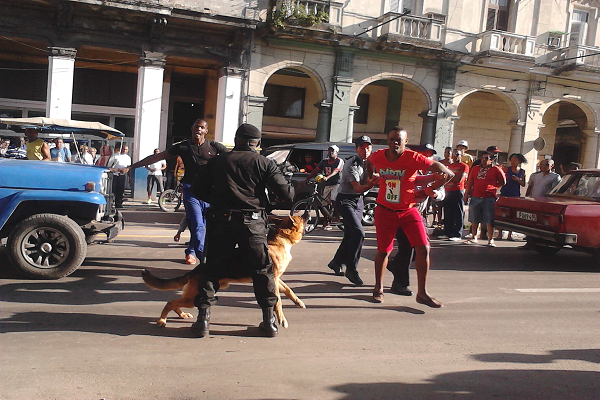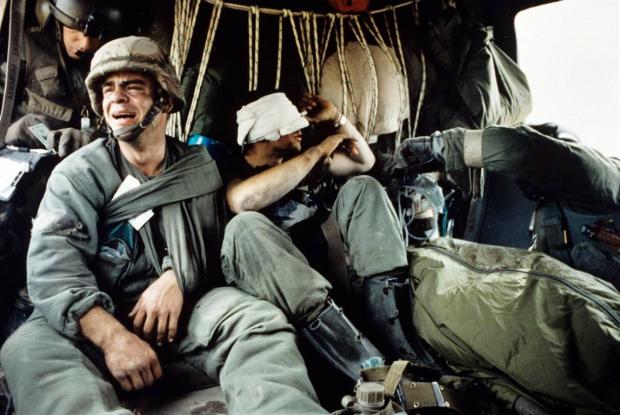Two reporters from the Pulitzer Center talked to us today about their work, the center’s mission, and what it really means to be embedded with military forces. Tom Hundley started out his story describing his work covering the first Gulf War after the Iraqi invasion of Kuwait. At the time, he was the bureau chief for the Chicago Tribune in Jerusalem, so he went to Saudi Arabia to cover the conflict. Unfortunately, the military was really only interested in getting positive coverage in light of media critique of the previous war in Vietnam, so he opted out of embedding and took advantage of his rare Saudi visa to cover other things that were happening at the time. As Hundley put it, the country was “discombobulated because Saddam was on their doorstep”, and the influx of Americans combined with women walking around without a head covering provided him with plenty of material.
Later he spent four years covering the breakup of Serbia and Ugoslavia, and recounted what took place when he and his “group of happy camper reporters” came upon a group of newly arrived American troops. He had already become comfortable in the relatively desolate area, but these troops were hyper-aware of their situation in enemy territory/combat zone. Interestingly, he explained that not carrying a gun of his own in this situation was a form of protection. “The only way to be safe was to be unarmed,” because during this war, anybody seen carrying a weapon was considered an enemy that could be shot at.
Another instance in which personal protection came into play was during the six months he spend in Baghdad after opening a bureau there once it had been secured by the US. Armed guards were stationed outside the bureau, and he and his office manager decided that one could be kept inside that only the two of them would know about, just in case of an emergency situation.
Meghan Dhaliwal entered the conversation after David Turnely’s award winning photo from the first Gulf War was mentioned (see below). As a photojournalist, she explained how, although there was conflict surrounding the taking of this picture as an invasion of an intimate moment, subjects being photographed like this “have much bigger things to worry about.” Furthermore, Turnely had been embedded for a significant amount of time at this point and had likely mastered the goal of an embedded photojournalist: to become a fly on the wall.
Meghan got her background in journalist from Boston University, and then went to Haiti with a public health student to report on the cholera outbreak thanks to a student grant from the Pulitzer Center. Upon return, she interned at the center for three months until taking over as multimedia projects coordinator. What this really translates to is a desk job, but Meghan had been aching to get back in the field for some time when the opportunity to report in Afghanistan was presented. With only twelve days notice, she was flown to Afghanistan to work with Meg Jones from the Milwaukee Journal Sentinel as the photographer for a story focusing on the effort in packing up a war. Meg is a veteran military correspondent, and her knowledge was invaluable to Meghan, who had almost know knowledge of how a military operated. Although her embedding would be very low risk, she still had to “sign her life away”, and was significantly more limited than when she had photographed in Haiti. Fortunately, her public affairs officer was as helpful as he could be– especially considering the fact that as a high-ranking captain, his constant presence with her made it hard for lower-ranking privates or specialists to relax when she was around.
To add to the difficulty, photographing things that weren’t there or that were on their way out was quite challenging. Meghan had to figure out how to show what was going on without being bland, but while still doing the necessary reporting. At times, this mandated starting her day at 4 AM when the light was still good. She wanted to show what life was like, not just life in a construction site, because construction sites are generally the same around the world.
In terms of censorship, it was assumed that her PA would stop her from photographing anything off limits, but this assumption proved faulty when she was addressed by three troops who had flown from a different part of Afghanistan, just to tell her in person that a photo she took for the Sentinel was against military protocol. In her PA’s presence, she had asked four troops to remove their helmets and sunglasses for a photo, and only later was told this wasn’t allowed. “I didn’t stop myself from taking pictures,” she said. ‘I wanted to show what was going on and how these people were living and how they were taking down the infrastructure used to fight a war for the last 13 years.”




